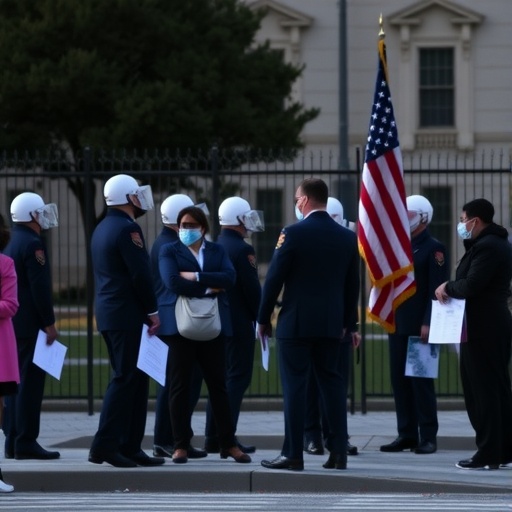Trump Administration Prioritizes ICE Funding Over Public Health Cuts in Government Shutdown Crisis
In a move that’s sparking outrage across the medical community, the Trump Administration is diverting federal funds to Immigration and Customs Enforcement (ICE) and military operations while slashing budgets for essential public health services amid the ongoing government shutdown. This prioritization, critics argue, leaves agencies like the Centers for Disease Control and Prevention (CDC) reeling from layoffs and program disruptions, potentially endangering national health security at a time when infectious disease threats loom large.
The shutdown, now stretching into its third week, has frozen non-essential government operations, but the Trump Administration‘s decisions on funding reallocations are drawing sharp scrutiny. Reports indicate that while ICE receives bolstered resources for border enforcement, public health initiatives—from flu vaccination drives to chronic disease research—are facing severe cutbacks. Health experts warn that these public health cuts could have long-term repercussions, including delayed responses to outbreaks and reduced access to vital preventive care.
Layoffs Cripple CDC Operations as Shutdown Bites
The CDC, a cornerstone of America’s public health infrastructure, is at the epicenter of the fallout from the Trump Administration’s public health cuts. Over 8,000 employees—more than a third of the agency’s workforce—have been furloughed without pay, according to internal memos leaked to major news outlets. This includes epidemiologists tracking seasonal flu strains and researchers developing strategies against emerging threats like antibiotic-resistant bacteria.
Dr. Elena Ramirez, a veteran CDC infectious disease specialist, shared her frustration in an exclusive interview: “We’re in the thick of flu season, and our teams are sidelined. Labs are shutting down, data analysis is halted, and we’re blind to potential hotspots. This isn’t just inconvenient; it’s a public safety risk.” Ramirez’s comments echo sentiments from the American Public Health Association, which estimates that the shutdown could delay critical reports on vaccine efficacy by up to six months.
Statistics paint a grim picture: The CDC’s budget for fiscal year 2019 was already under strain at $7.2 billion, but the shutdown has halted $1.2 billion in ongoing grants for state and local health departments. Programs like the Childhood Immunization Initiative, which vaccinates millions of kids annually, are now in limbo, with field workers unable to distribute supplies or conduct outreach. In states like California and New York, where measles outbreaks were recently contained, officials fear a resurgence without federal support.
These layoffs aren’t isolated; the National Institutes of Health (NIH) reports similar disruptions, with clinical trials paused and grant applications piling up unprocessed. A study by the Brookings Institution highlights that previous shutdowns cost the economy $11 billion, but the human toll in public health cuts is harder to quantify—though experts like those at Johns Hopkins University predict up to 10,000 preventable illnesses if disruptions persist.
ICE Funding Surge Sparks Debate on Priorities
While public health agencies grapple with uncertainty, ICE funding under the Trump Administration appears insulated from the shutdown’s chaos. Documents obtained by The Washington Post reveal that ICE’s budget for detention and deportation operations has been maintained at $8.5 billion, with supplemental allocations from emergency military funds. This ICE funding boost comes as the agency expands family detention centers along the southern border, housing over 15,000 migrants amid humanitarian concerns.
White House Press Secretary Sarah Sanders defended the allocation during a briefing, stating, “Protecting our borders is a national security imperative, and the President has ensured that frontline agents have the resources they need.” Yet, this stance has fueled accusations of misplaced priorities. Senate Minority Leader Chuck Schumer lambasted the approach: “In the midst of a shutdown that hurts everyday Americans, we’re funding walls and raids while kids go unvaccinated and diseases spread unchecked.”
The contrast is stark: Military spending, too, remains robust at $700 billion annually, with no reported furloughs for defense contractors. Meanwhile, the Department of Health and Human Services (HHS) has seen 40% of its staff sidelined, affecting everything from food safety inspections to mental health hotlines. A Government Accountability Office (GAO) report from the last shutdown warned of similar imbalances, noting that reallocating funds from health to enforcement eroded trust in federal responsiveness.
Advocacy groups like the ACLU argue that the ICE funding emphasis diverts from core governance duties. “Public health cuts aren’t just budget line items; they’re lives at stake,” said Maria Gonzalez, policy director at the National Immigration Law Center. Data from U.S. Customs and Border Protection shows ICE operations ramping up, with deportation flights increasing by 20% in recent weeks, even as health services falter.
Critical Health Programs Face Uncertain Futures
Beyond the CDC, a cascade of public health programs is teetering on the brink due to the Trump Administration’s fiscal maneuvers. The Substance Abuse and Mental Health Services Administration (SAMHSA) has suspended opioid crisis response grants, leaving rural communities without naloxone distribution kits. In Appalachia, where overdose deaths topped 20,000 last year, local clinics report stock shortages and delayed training sessions.
The Environmental Protection Agency (EPA), often overlapping with health mandates, has halted water quality testing in 200 communities, raising alarms about lead exposure in aging infrastructure. A coalition of pediatricians from the American Academy of Pediatrics issued a statement: “These public health cuts during a shutdown are shortsighted. Children’s health—from asthma management to lead poisoning prevention—depends on uninterrupted federal support.”
Statistics underscore the vulnerability: The CDC’s National Center for Health Statistics can’t update mortality data, blinding policymakers to trends in heart disease and cancer. Federally Qualified Health Centers (FQHCs), serving 28 million low-income patients, face reimbursement delays totaling $400 million, per the National Association of Community Health Centers. This could force clinic closures, exacerbating access disparities in underserved areas.
Historical context adds weight: During the 2013 shutdown, similar public health cuts led to a 15% drop in HIV testing rates, according to a later CDC analysis. Today, with the opioid epidemic raging and flu cases surging, the stakes are higher. Experts from the World Health Organization have expressed concern, noting that U.S. disruptions could impact global surveillance networks reliant on American data sharing.
Expert Warnings and Bipartisan Backlash Mount
As the shutdown persists, voices from across the political spectrum are uniting against the Trump Administration’s handling of public health cuts. Former CDC Director Dr. Tom Frieden took to Twitter: “This is a dangerous game. Prioritizing ICE funding over outbreak preparedness invites disaster.” Bipartisan lawmakers, including Republicans like Sen. Susan Collins, have called for emergency health funding bills, warning of cascading effects on the economy.
The economic ripple is profound: Healthcare spending accounts for 18% of U.S. GDP, and disruptions could cost billions in lost productivity. A Moody’s Analytics forecast predicts that prolonged public health cuts might inflate healthcare costs by 5% next year due to untreated conditions snowballing into emergencies. Labor unions representing federal workers report morale at rock bottom, with 95% of furloughed HHS employees fearing long-term job losses.
International repercussions are emerging too. Partners in the Global Health Security Agenda, a U.S.-led initiative, have paused joint exercises on pandemic response, citing unreliable American participation. This comes as China and Russia position themselves as more stable health diplomacy players, potentially shifting global alliances.
Grassroots responses are mobilizing: Petitions on Change.org have garnered 500,000 signatures urging Congress to exempt health agencies from shutdown impacts. Nonprofits like the Red Cross are stepping in with ad-hoc flu clinics, but their capacity is limited compared to federal resources.
Path Forward: Negotiations and Potential Reforms
Looking ahead, the path out of this crisis hinges on Capitol Hill negotiations. House Speaker Nancy Pelosi has vowed to tie any shutdown resolution to restored public health funding, demanding $2 billion in emergency allocations for the CDC and NIH. The Trump Administration, however, insists on border wall concessions, prolonging the standoff.
If resolved soon, experts say catch-up efforts could mitigate damage—ramping up vaccinations before peak flu season and resuming data flows. But prolonged delays might necessitate congressional reforms, like the proposed SHIELD Act, which would protect health agencies from future shutdowns. Bipartisan support for such measures is growing, with polls from Gallup showing 72% of Americans prioritizing health funding over immigration enforcement during crises.
The broader implications extend to election-year politics: Public health cuts could become a flashpoint, with Democrats framing it as neglect of vulnerable populations. For the Trump Administration, balancing ICE funding with health imperatives will test its governance narrative. As one Hill staffer put it anonymously, “This shutdown isn’t just about budgets; it’s about what America values—security at the border or health at home.” Ultimately, the resolution will shape not only immediate health outcomes but the nation’s resilience against future threats, from pandemics to everyday ailments.










